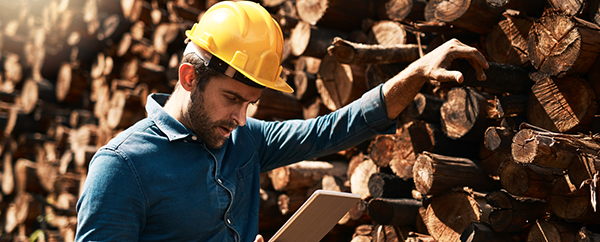Help your clients manage logging equipment risks
- Logging equipment hazards fall into two major categories: fire and equipment slipping, sinking or rolling over.
- Know the most common combustibles and ignition sources for fires, and how to prevent them.
- Operating logging equipment on steep grades is also hazardous. Follow these safety steps.
In logging and forestry operations, equipment losses are most often caused by equipment fires, sinking, slipping and rollover. We’ll discuss these logging equipment risks, along with strategies your logging clients can use to limit the probability of hazardous loss. This information is provided by our carrier Zurich.
The most common logging equipment risk: Equipment fire
Fire is the leading cause of total loss for heavy equipment used in logging and forestry operations. Many elements can cause equipment fire and total loss, including:
Common Combustibles:
- Wood chips
- Branches
- Combustible hydraulic fluid
- Grease accumulation
- Dust in and around machinery
Common Ignition Sources:
- Electrical faults
- Hot engines
- Exhaust surfaces
The self-ignition temperature of wood varies among wood species. The NFPA indicates that the most common ignition temperature of wood is in approximately 200˚C or 392˚F. Low density species, such as softwood, ignite at lower temperatures; high density species or hard woods ignite at higher temperatures. Under test conditions, when wood is in direct contact with a heated surface, a fire can be ignited within a time span of 6 – 40 minutes, depending on the rate of heating and wood species. The operating temperature of a hot diesel engine ranges from 300˚F at idle load to 1200˚F under full operating load.
Fighting logging equipment fire is inherently challenging; the remoteness of operations and equipment increases this challenge. There may not be a nearby fire department to respond to your fire. Even if your operation employs a fire brigade, getting to remote equipment set deep in a forest can delay crucial response time. So, your first objective in fire prevention must be to limit the probability of fire occurrence.
Isolating and controlling combustibles and ignition sources is the most effective way to prevent the most common of logging equipment risks. These practices have been proven to vastly reduce loss:
- Sweep combustible wood chips, dust and limb accumulation from equipment at regular frequencies. Increase how often you sweep when risk of forest fire is high.
- Document cleaning frequency to ensure it’s performed according to plan.
- Remove excessive grease accumulation from skid plates.
- Install a fire suppression system to equipment where the operation is susceptible to heavy accumulation of combustible debris.
- Inspect and maintain fixed fire suppression systems. The main cause of fixed fire suppression failure is due to poor or lack of required maintenance.
- Establish written required safety protocols for the refueling station, mobile unit. Audit routinely to enforce protocols such as
- Keeping on hand a fully charged fire extinguisher
- Shutting down heavy equipment before fueling
- A no smoking policy
- Refueling is performed at safe distances from other equipment to ensure multiple vehicles are not involved in a fueling mishap resulting in fire
- Conduct regular cleaning of combustible accumulation.
- Conduct routine equipment inspections to ensure all equipment is functioning properly, including a close look for an exhaust leak.
- When equipment is shut down at the end of the day, include a 30-minute observation period to monitor for potential fire ignition.
Related: Top reasons to add Forestry & Logging Program to your producer portfolio
Equipment Slipping, Rollover and Sinking
Heavy equipment can easily slip, tip and roll on steep gradients, especially if operated over logs, stumps, moss or ice covered rock, and sink into soft grade, swamp and bogs. Here are preventative to manage and avoid such logging equipment risks from occurring:
- Carefully inspect and clearly mark all hazards found within the work area that may lead to the equipment sinking, tipping, or dropping trees on roads, other equipment or co-workers.
- Mark emergency evacuation routes onsite. Keep emergency routes clear of any equipment or material storage.
- Provide an adequate number of portable fire extinguishers to fight fires and to replace discharged fire extinguishers. Train employees on the use and inspection of fire protection equipment.
- Enforce a ‘No Smoking’ policy.
Related: Workplace accidents and best practices for incident reporting
Operating equipment on steep grades
These practices can also help minimize logging equipment risks when operating on steep gradients:
- Avoid running over logs or stumps when travelling across gradients – they can destabilize equipment and potentially tip over.
- Travel along a path which you have already walked and inspected, so you aren’t surprised by unstable ground.
- Maintain the position of travelling directly up and down steep gradients instead of driving across a slope, which reduces the stability of the equipment.
- Provide equipment tracks with ice lugs to improve traction during winter operation.
- Conduct welding, but only with an observer on hand to monitor welding sparks. Have a fire extinguisher ready. Welding should be performed where there are no combustibles, such as on gravel or earth bed. Once welding is completed, the area should be monitored for no less than 30 minutes to ensure there are no smoldering embers that will ignite a fire.
Agents, take a look at our Forestry & Logging Program to add to your portfolio of insurance solutions.

